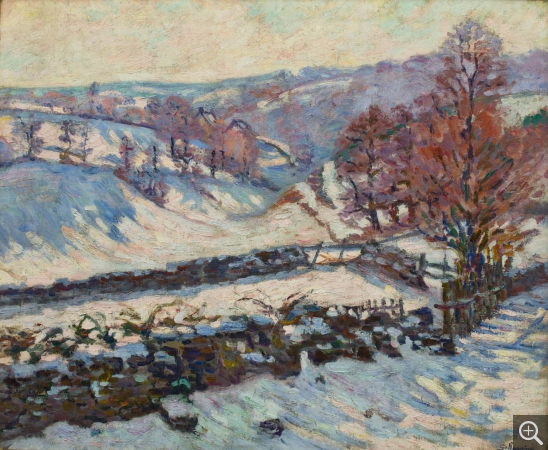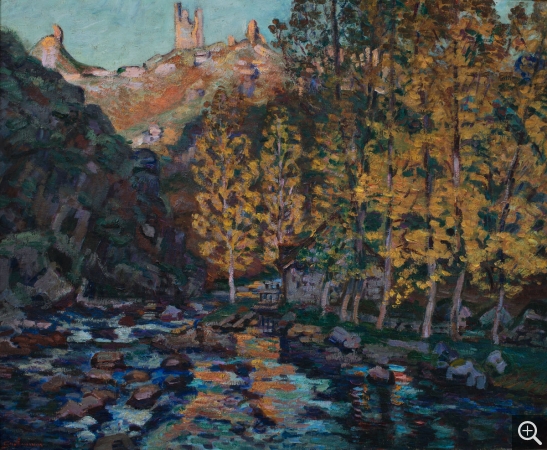Impressionism
English
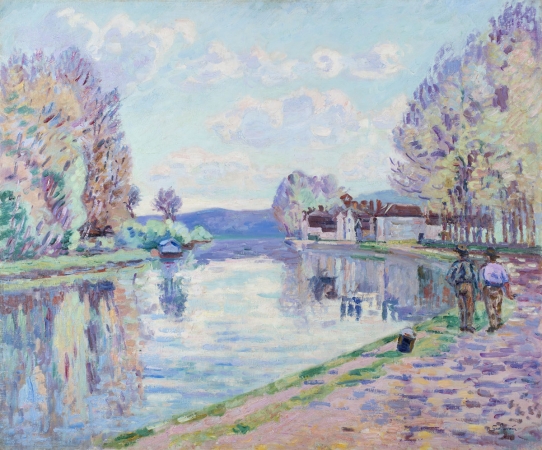
Armand GUILLAUMIN (1841-1927)
The Seine at Samois
ca. 1898
oil on canvas
60 x 73 cm
© MuMa Le Havre / Charles Maslard
The Seine at Samois
ca. 1898
oil on canvas
60 x 73 cm
© MuMa Le Havre / Charles Maslard
HD image
Like Claude Monet and the Impressionist painters, Armand Guillaumin was fascinated by the play of light on water. In his painting The Seine at Samois, the artist, who had been working in the Paris region for several years, set up his easel on the banks of the Seine along a path lined with poplar trees. It was the ideal location for capturing the changing light of the Ile-de-France sky on the surface of the water. Several sturdy buildings, typical of the Bas-Samois area, close the perspective.
Guillaumin returned to the village on several occasions between 1898 and 1902, producing a dozen or so works painted from nature. Dividing his attention between the old town of Samois and the more recent buildings of the Bas-Samois, he alternated between broad views over the river or narrower views of the houses.
The Seine at Samois, acquired by Olivier Senn at an unknown date, completes a set with two other paintings the artist produced in the Creuse, Snowy Landscape at Crozant and The Creuse at Crozant, which joined the MuMa collection in 2005.
Guillaumin returned to the village on several occasions between 1898 and 1902, producing a dozen or so works painted from nature. Dividing his attention between the old town of Samois and the more recent buildings of the Bas-Samois, he alternated between broad views over the river or narrower views of the houses.
The Seine at Samois, acquired by Olivier Senn at an unknown date, completes a set with two other paintings the artist produced in the Creuse, Snowy Landscape at Crozant and The Creuse at Crozant, which joined the MuMa collection in 2005.
Learn more
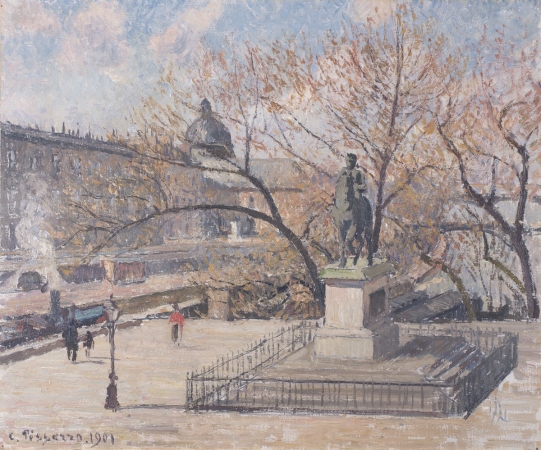
Camille PISSARRO (1831-1903)
Statue of Henri IV and Hôtel de la Monnaie, Morning, Sun
1901
oil on canvas
46 x 55 cm
© MuMa Le Havre / Charles Maslard
Statue of Henri IV and Hôtel de la Monnaie, Morning, Sun
1901
oil on canvas
46 x 55 cm
© MuMa Le Havre / Charles Maslard
HD image
Working from his apartment at 28, place Dauphine in Paris, Pissarro strove, for the second time, to paint different views of the Louvre and the Seine from his window. The Statue of Henri IV and Hôtel de la Monnaie, Morning, Sun belongs to the "second series" and is part of a set of 26 paintings executed between October 31, 1901 and May 17, 1902. The painting in the Mathey collection focuses on the statue of Henri IV in the foreground, with the Hôtel de la Monnaie and the dome of the Institut overhead in the background to close the composition. A curtain of trees in their autumn glory creates a link between the different spaces.
Only three works in the series explore the motif from this angle, for after these paintings, Pissarro shifted his gaze to the right bank and concentrated on the long line of buildings forming the Louvre and the Pont du Carrousel. The subject allowed him to obtain a much greater depth of field and to play with the effects of the air and light between the waters of the Seine and the sky. The three seasons that punctuated his stay gave the artist a variety of landscapes that changed according to the weather, the time of day and the number of people that frequented them.
Pissarro's financial difficulties forced him to change his plans to travel to the South, so he spent the winter working on a new series of views of the Louvre and the Seine—a total of 13 paintings, including four of the Henri IV statue. During that same period, the artist decided to diversify his motifs and rented a room in a hotel on the quai Colbert. The Pont Royal and Pont du Carrousel thus became the subjects of several paintings. Dividing his time between the two locations, the artist painted his third and fourth series on this new motif between November 13, 1902 and May 29, 1903.
Only three works in the series explore the motif from this angle, for after these paintings, Pissarro shifted his gaze to the right bank and concentrated on the long line of buildings forming the Louvre and the Pont du Carrousel. The subject allowed him to obtain a much greater depth of field and to play with the effects of the air and light between the waters of the Seine and the sky. The three seasons that punctuated his stay gave the artist a variety of landscapes that changed according to the weather, the time of day and the number of people that frequented them.
Pissarro's financial difficulties forced him to change his plans to travel to the South, so he spent the winter working on a new series of views of the Louvre and the Seine—a total of 13 paintings, including four of the Henri IV statue. During that same period, the artist decided to diversify his motifs and rented a room in a hotel on the quai Colbert. The Pont Royal and Pont du Carrousel thus became the subjects of several paintings. Dividing his time between the two locations, the artist painted his third and fourth series on this new motif between November 13, 1902 and May 29, 1903.
Learn more
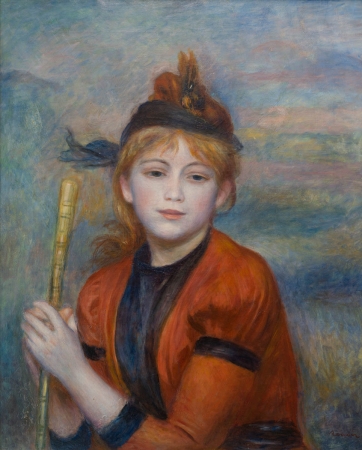
Pierre-Auguste RENOIR (1841-1919)
The Excursionist
ca. 1888
oil on canvas
61.5 x 50 cm
© MuMa Le Havre / David Fogel
The Excursionist
ca. 1888
oil on canvas
61.5 x 50 cm
© MuMa Le Havre / David Fogel
HD image
Of all the Impressionists, Auguste Renoir (1841–1919) was the only one who never ceased to paint human figures, and more particularly women.
Although The Excursionist from the Marande collection has not been dated, it was likely painted around 1888, when Renoir sought to produce works depicting elegant young women in the costume of the day. The chosen models are shown playing the piano, gossiping, strolling in the countryside, and their company is reminiscent of the peaceful, happy atmosphere of garden parties in 18th-century France. The female figure is seated facing forward, looking at the viewer. The walking stick in her hand provides the only explanation for the title of the painting. The elements forming the landscape are very vague and appear more as coloured notes used to support the more pronounced colour of the figure. Despite giving the impression of being painted outdoors, it was presumably composed in the studio.
A transitional piece, The Excursionist was painted in thin layers that allow for the subtle passage from one colour to the next. The Impressionist brushstrokes are practically gone, giving way to a smooth and fluid painting style. Typical of Renoir's portrayals of young women in the first decade of the 20th century, this peaceful and luminous painting appears to be the picture of happiness, as handed down to us by the Impressionist masters.
Although The Excursionist from the Marande collection has not been dated, it was likely painted around 1888, when Renoir sought to produce works depicting elegant young women in the costume of the day. The chosen models are shown playing the piano, gossiping, strolling in the countryside, and their company is reminiscent of the peaceful, happy atmosphere of garden parties in 18th-century France. The female figure is seated facing forward, looking at the viewer. The walking stick in her hand provides the only explanation for the title of the painting. The elements forming the landscape are very vague and appear more as coloured notes used to support the more pronounced colour of the figure. Despite giving the impression of being painted outdoors, it was presumably composed in the studio.
A transitional piece, The Excursionist was painted in thin layers that allow for the subtle passage from one colour to the next. The Impressionist brushstrokes are practically gone, giving way to a smooth and fluid painting style. Typical of Renoir's portrayals of young women in the first decade of the 20th century, this peaceful and luminous painting appears to be the picture of happiness, as handed down to us by the Impressionist masters.
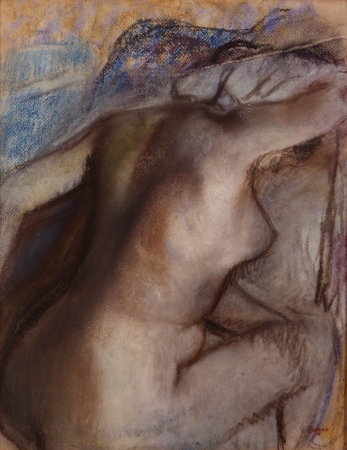
Edgar DEGAS (1834-1917)
After the Bath, Woman Drying Herself
ca. 1884-1886 / 1890 / 1900
pastel on wove paper
40.5 x 32 cm
© MuMa Le Havre / Florian Kleinefenn
After the Bath, Woman Drying Herself
ca. 1884-1886 / 1890 / 1900
pastel on wove paper
40.5 x 32 cm
© MuMa Le Havre / Florian Kleinefenn
HD image
At an auction in Paris in 1908, Olivier Senn, an art collector from Le Havre, bought his first pastel by Edgar Degas (1834–1917), a woman washing herself. At this time, artworks by the withdrawn artist were already rare on the market and negotiated at very high prices. Upon Degas' death, his studio collection was dissolved over four public sales. A big event, these open auctions drew the greatest collectors from France and abroad. Olivier Senn, who under no circumstances wanted to miss this opportunity, was there the first day of the first sale, on May 6, 1918, and came away with a substantial set of forty-six drawings. He sent a representative for the following auctions, but not without giving very specific purchasing instructions. This is how he obtained the pastel, one of the highest transactions of the second auction. Sold for 26,000 francs, this artwork is without a doubt one of the masterpieces of the Olivier Senn collection.
Degas executed his first pastels of women washing themselves around 1876–1877. He produced another extensive series in the 1880s and exhibited seven of the works at the eighth and final Impressionist exhibition in 1886. The series, entitled "Suite of female nudes, bathing, washing, drying themselves, wiping themselves, combing their hair or having their hair combed", inspired harsh criticism and fuelled the controversy on the artist's misogyny.
Captured in the privacy of their bedroom, as if unbeknownst to them, the women go about their bathing. The artist shows them crouching in their tub (a large, flat basin), rinsing, standing, drying themselves on a chair or armchair... The unaffected gestures are highlighted by views from above and truncated frames replicated by the artist drawing after drawing.
In our pastel, the young woman in three-quarter profile, her face bent forward hidden by her raised right arm, is drying the nape of her neck with a towel. She is sitting on a settee, the back of which is upholstered with mauve and ultramarine fabric, in front of a bathtub that can be made out in the background to the left. The rather tight frame accentuates the young woman's outstretched body, her left arm thrown behind her, almost in line with the right arm raised in front.
The drawing is immediately intriguing by its complexity. Two aspects especially draw the most attention: the long fold of paper in the upper right, like a scar that divides two sections treated in very different manners; and the work of the pastel itself, powdery on rough paper at one end, smooth and polished at the extreme of the other.
It would seem that Degas worked in two stages, first concentrating on the woman's body, then reworking his drawing to complete certain sections at the top of the sheet and defining the contours with hatching. The different treatments suggest that the drawing was reworked after several years and, by stylistic comparison, likely between 1880 and 1890.
Degas experiments here with all of the resources pastel has to offer: powdery and adhering unevenly to the coarse-grained paper, applied in successive layers, dampened to obtain a homogenous paste delicately worked to recreate the plasticity, fullness and softness of the female skin tone. Although the fold most likely occurred when the pastel was dampened, Degas did not try to conceal it; on the contrary, he accepted the accident for the possibilities it provided him and used it as a source of innovation.
Complex by its execution, intriguing by the questions it raises on the stages of its creation, After the Bath, Woman Drying Herself is above all an extremely sensual work, in which the woman's body is almost demanding to be caressed.
Degas executed his first pastels of women washing themselves around 1876–1877. He produced another extensive series in the 1880s and exhibited seven of the works at the eighth and final Impressionist exhibition in 1886. The series, entitled "Suite of female nudes, bathing, washing, drying themselves, wiping themselves, combing their hair or having their hair combed", inspired harsh criticism and fuelled the controversy on the artist's misogyny.
Captured in the privacy of their bedroom, as if unbeknownst to them, the women go about their bathing. The artist shows them crouching in their tub (a large, flat basin), rinsing, standing, drying themselves on a chair or armchair... The unaffected gestures are highlighted by views from above and truncated frames replicated by the artist drawing after drawing.
In our pastel, the young woman in three-quarter profile, her face bent forward hidden by her raised right arm, is drying the nape of her neck with a towel. She is sitting on a settee, the back of which is upholstered with mauve and ultramarine fabric, in front of a bathtub that can be made out in the background to the left. The rather tight frame accentuates the young woman's outstretched body, her left arm thrown behind her, almost in line with the right arm raised in front.
The drawing is immediately intriguing by its complexity. Two aspects especially draw the most attention: the long fold of paper in the upper right, like a scar that divides two sections treated in very different manners; and the work of the pastel itself, powdery on rough paper at one end, smooth and polished at the extreme of the other.
It would seem that Degas worked in two stages, first concentrating on the woman's body, then reworking his drawing to complete certain sections at the top of the sheet and defining the contours with hatching. The different treatments suggest that the drawing was reworked after several years and, by stylistic comparison, likely between 1880 and 1890.
Degas experiments here with all of the resources pastel has to offer: powdery and adhering unevenly to the coarse-grained paper, applied in successive layers, dampened to obtain a homogenous paste delicately worked to recreate the plasticity, fullness and softness of the female skin tone. Although the fold most likely occurred when the pastel was dampened, Degas did not try to conceal it; on the contrary, he accepted the accident for the possibilities it provided him and used it as a source of innovation.
Complex by its execution, intriguing by the questions it raises on the stages of its creation, After the Bath, Woman Drying Herself is above all an extremely sensual work, in which the woman's body is almost demanding to be caressed.
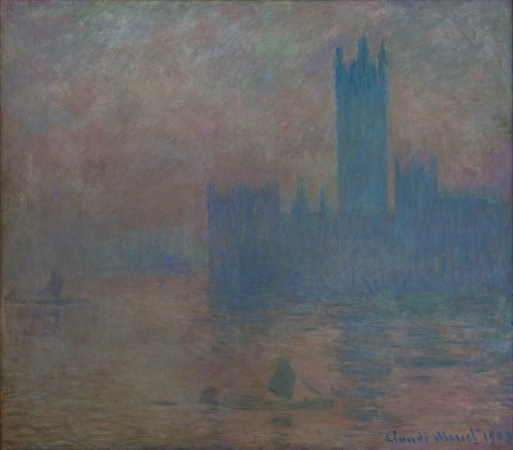
Claude MONET (1840-1926)
London Parliament
1903
oil on canvas
81 x 92 cm
© MuMa Le Havre / David Fogel
London Parliament
1903
oil on canvas
81 x 92 cm
© MuMa Le Havre / David Fogel
HD image
After a brief trip to London in 1870, Claude Monet (1840–1926) was invited back in 1887 by the painter Whistler. Captivated by the city, he decided to return the following years to paint some of "the effects of fog on the Thames". After four years spent observing the motif, Monet began a major series on the capital city in his Giverny studio. Through constant and simultaneous work on all of the paintings, he succeeded in completing thirty-seven canvases in 1904 with the aim of exhibiting them.
London Parliament belongs to the series comprising around one hundred works in which Monet focuses on three motifs: the bridges of Charing Cross and Waterloo, as well as the House of Parliament. But the true subject of these paintings is the changing weather and light that bathe the monuments of the London skyline. This painting with subtle violet and purplish blue washes evokes Monet's passionate investigations into recreating the distinctive effects of fog in the English capital. Tinged with the memory of Turner's work, which Monet discovered in 1870–1871, it can be especially compared to Whistler's Nocturnes.
In May–June 1904, the Durand-Ruel gallery in Paris held a vast exhibition exclusively dedicated to these "Views of the Thames in London". Hailed as a major event by critics, the exhibition was also very well received by art connoisseurs. A few days after the opening, on May 19, a collector from Le Havre by the name of Pieter van der Velde purchased a painting from the large-scale series "Westminster Palace" for the considerable sum of 18,000 francs.
Not only did he enrich his own collection, Van der Velde, with the support of his friends Dusseuil and Marande, two members of the acquisitions committee for the Le Havre museum, was likely a key participant in the municipality's negotiations with Monet in 1910. The name of the Impressionist master had been mentioned by the committee as early as 1901, but it was ten years before three of the artist's paintings graced the municipal collections: Cliffs at Varengeville, Waterlilies and London Parliament. Purchased directly from the artist for the symbolic amount of 3,000 francs, these paintings were added to the small collection of Impressionist works—a painting by Maufra and two Views of the Port of Le Havre by Pissarro—that entered the museum's collections in 1903.
London Parliament belongs to the series comprising around one hundred works in which Monet focuses on three motifs: the bridges of Charing Cross and Waterloo, as well as the House of Parliament. But the true subject of these paintings is the changing weather and light that bathe the monuments of the London skyline. This painting with subtle violet and purplish blue washes evokes Monet's passionate investigations into recreating the distinctive effects of fog in the English capital. Tinged with the memory of Turner's work, which Monet discovered in 1870–1871, it can be especially compared to Whistler's Nocturnes.
In May–June 1904, the Durand-Ruel gallery in Paris held a vast exhibition exclusively dedicated to these "Views of the Thames in London". Hailed as a major event by critics, the exhibition was also very well received by art connoisseurs. A few days after the opening, on May 19, a collector from Le Havre by the name of Pieter van der Velde purchased a painting from the large-scale series "Westminster Palace" for the considerable sum of 18,000 francs.
Not only did he enrich his own collection, Van der Velde, with the support of his friends Dusseuil and Marande, two members of the acquisitions committee for the Le Havre museum, was likely a key participant in the municipality's negotiations with Monet in 1910. The name of the Impressionist master had been mentioned by the committee as early as 1901, but it was ten years before three of the artist's paintings graced the municipal collections: Cliffs at Varengeville, Waterlilies and London Parliament. Purchased directly from the artist for the symbolic amount of 3,000 francs, these paintings were added to the small collection of Impressionist works—a painting by Maufra and two Views of the Port of Le Havre by Pissarro—that entered the museum's collections in 1903.
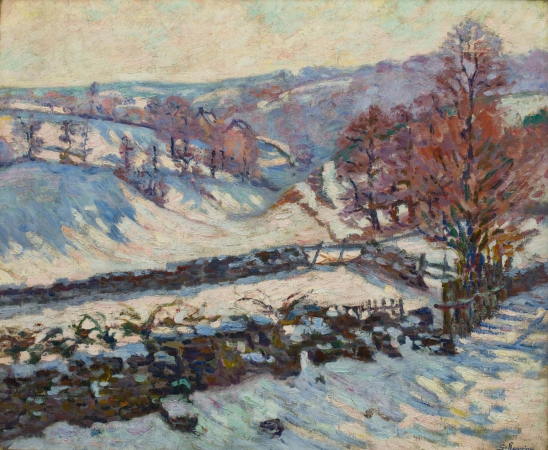
Armand GUILLAUMIN (1841-1927)
Snowy Landscape at Crozant
vers 1895
oil on canvas
60 x 73 cm
© MuMa Le Havre / David Fogel
Snowy Landscape at Crozant
vers 1895
oil on canvas
60 x 73 cm
© MuMa Le Havre / David Fogel
HD image
Far away from Paris, the Creuse, a harsh and hostile land marked by severe winters, began to appear on the walls of the Salon de Paris in 1830. George Sand's novels set in the countryside made the region known and drew the first "open-air" painters to Nohant. Monet stayed in Fresselines from March to May 1889, but he cursed the changeable weather that required a constant reworking of his paintings. When Armand Guillaumin (1841–1927) followed Monet's example three years later, his robust constitution also had difficulty with the harshness of the Creuse.
But the artist was determined to explore his motif through and through, and get at its truth. As the lucky winner of the lottery, he was able to retire from his job and devote himself wholly to painting, spending almost all of the rest of his life at Crozant, from 1892 to 1924. He painted daily, regardless of the season, but art connoisseurs especially enjoyed his winter landscapes, the "Gelées blanches" (white frosts), which earned him a triumphant success at the major exhibition art dealer Durand-Ruel held in his honour in 1894, featuring no less than one hundred paintings and pastels.
In Snowy Landscape at Crozant, Guillaumin succeeds in stirring colours with a vibrant intensity. He pushes his application of Impressionist theories to the limit. In contrast to Monet's timid and delicate depictions of winter sensations, Guillaumin displays the full depth of the substance.
This landscape of the Creuse, clearly identified as the Grandes Gouttes, reappears in Guillaumin's works through the seasons. He painted it with a bright orange palette in March 1902, under grey skies or a thin layer of frost, sometimes more than once in the same month. This profusion of works on the same theme makes dating the paintings very difficult.
In 1907, Guillaumin sent a Chemin des Gouttes (Snow) to the Cercle de l'Art Moderne exhibition in Le Havre. This may have been the painting acquired by collector Olivier Senn.
But the artist was determined to explore his motif through and through, and get at its truth. As the lucky winner of the lottery, he was able to retire from his job and devote himself wholly to painting, spending almost all of the rest of his life at Crozant, from 1892 to 1924. He painted daily, regardless of the season, but art connoisseurs especially enjoyed his winter landscapes, the "Gelées blanches" (white frosts), which earned him a triumphant success at the major exhibition art dealer Durand-Ruel held in his honour in 1894, featuring no less than one hundred paintings and pastels.
In Snowy Landscape at Crozant, Guillaumin succeeds in stirring colours with a vibrant intensity. He pushes his application of Impressionist theories to the limit. In contrast to Monet's timid and delicate depictions of winter sensations, Guillaumin displays the full depth of the substance.
This landscape of the Creuse, clearly identified as the Grandes Gouttes, reappears in Guillaumin's works through the seasons. He painted it with a bright orange palette in March 1902, under grey skies or a thin layer of frost, sometimes more than once in the same month. This profusion of works on the same theme makes dating the paintings very difficult.
In 1907, Guillaumin sent a Chemin des Gouttes (Snow) to the Cercle de l'Art Moderne exhibition in Le Havre. This may have been the painting acquired by collector Olivier Senn.
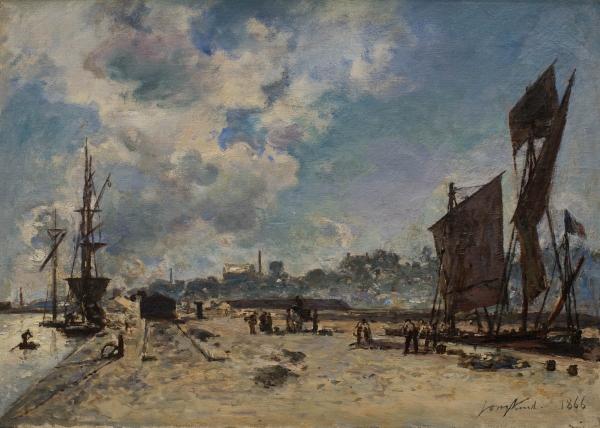
Johan Barthold JONGKIND (1819-1891)
Quay at Honfleur
1866
oil on canvas
32.5 x 46 cm
© MuMa Le Havre / David Fogel
Quay at Honfleur
1866
oil on canvas
32.5 x 46 cm
© MuMa Le Havre / David Fogel
HD image
After studying at the Academy of Art in The Hague, Johan Barthold Jongkind (1819–1891) met French painter Eugène Isabey in 1845 and followed him to Paris the following year. In 1850, he travelled for the first time to Normandy with Isabey, stopping in Honfleur, Fécamp, Yport and Saint-Valéry-en-Caux. Upon his return to Paris, Jongkind submitted to the Salon a View of the Harfleur Harbour, acquired by the State (Musée de Picardie, Amiens).
From 1862 to 1865, Jongkind made a number of trips to Normandy. His repeated sojourns in Honfleur gave him countless opportunities at the Saint-Siméon farm and on the Côte de Grâce to meet with his painter and poet friends, the Troyon brothers, Sisley, Corot and Cals, as well as Courbet and Baudelaire. During this time, he befriended Boudin and met the young Claude Monet. In their company or alone, Jongkind explored the coast, the quays of the harbour, and the streets and tiny squares of the Norman village. The harbour, the coming and going of the big ships, the lively quays and the shipbuilding sites became his favourite motifs.
Jongkind spent the summer of 1865 in Honfleur, where he painted a number of landscapes, such as View from the Harbour to the Railway (Kunsthaus Zürich), which is of the same size and similar in nature to Quay at Honfleur. He used the same composition eleven years later to produce two other very similar versions, but larger in size.
Jongkind was at the height of his art. In Quay at Honfleur, the composition is divided between a very open foreground showing signs of modern industrial activity (unloading docks, machines, hoists and pulleys, railway tracks, men at work) and a cloudy sky, a sumptuous piece of painting with energetic brushstrokes executed in thick paint. As often the case in his harbour scenes and riverscapes, the channel, basin or river suggest depth, strengthened here by the railway tracks.
Although he was absent from the first Impressionist exhibition in 1874, Jongkind was an important precursor of Impressionism. In the preface to the catalogue issued for the first posthumous sale of Jongkind's art on December 7 and 8, 1891, Louis de Fourcaud wrote, "In the future he will be recognized as the link, between Corot and Claude Monet, from one era to the next." Olivier Senn, an art connoisseur from Le Havre, was not mistaken when he took care to add this magnificent artwork to his collection, along with works by Corot, Monet, Courbet and Boudin.
From 1862 to 1865, Jongkind made a number of trips to Normandy. His repeated sojourns in Honfleur gave him countless opportunities at the Saint-Siméon farm and on the Côte de Grâce to meet with his painter and poet friends, the Troyon brothers, Sisley, Corot and Cals, as well as Courbet and Baudelaire. During this time, he befriended Boudin and met the young Claude Monet. In their company or alone, Jongkind explored the coast, the quays of the harbour, and the streets and tiny squares of the Norman village. The harbour, the coming and going of the big ships, the lively quays and the shipbuilding sites became his favourite motifs.
Jongkind spent the summer of 1865 in Honfleur, where he painted a number of landscapes, such as View from the Harbour to the Railway (Kunsthaus Zürich), which is of the same size and similar in nature to Quay at Honfleur. He used the same composition eleven years later to produce two other very similar versions, but larger in size.
Jongkind was at the height of his art. In Quay at Honfleur, the composition is divided between a very open foreground showing signs of modern industrial activity (unloading docks, machines, hoists and pulleys, railway tracks, men at work) and a cloudy sky, a sumptuous piece of painting with energetic brushstrokes executed in thick paint. As often the case in his harbour scenes and riverscapes, the channel, basin or river suggest depth, strengthened here by the railway tracks.
Although he was absent from the first Impressionist exhibition in 1874, Jongkind was an important precursor of Impressionism. In the preface to the catalogue issued for the first posthumous sale of Jongkind's art on December 7 and 8, 1891, Louis de Fourcaud wrote, "In the future he will be recognized as the link, between Corot and Claude Monet, from one era to the next." Olivier Senn, an art connoisseur from Le Havre, was not mistaken when he took care to add this magnificent artwork to his collection, along with works by Corot, Monet, Courbet and Boudin.
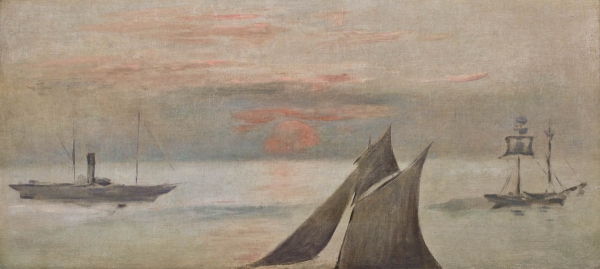
Édouard MANET (1832-1883)
Boats at Sea, Sunset
ca. 1868
oil on canvas
43 x 94 cm
© MuMa Le Havre / David Fogel
Boats at Sea, Sunset
ca. 1868
oil on canvas
43 x 94 cm
© MuMa Le Havre / David Fogel
HD image
After refusing to study law as his father had wished and a failed attempt to enter the Naval College, Édouard Manet (1832–1883) enrolled in the atelier of Thomas Couture in 1850 and began his training as a painter. Rejected by the official exhibitions, the young artist played a leading role in the elegant bohemian life of Paris. He kept company with the painters Fantin-Latour and Degas, who lent him their support, and men of letters like the poet Baudelaire and novelist Zola, for whom he painted a famous portrait. Manet was enthusiastic about the creation of the Salon des Refusés, where he was able to present his celebrated Luncheon on the Grass in 1863 followed by Olympia two years later.
Between 1868 and 1873, Manet often spent his summers on the Normandy coast, which he knew well from when he was a child. He painted numerous seascapes, at Boulogne-sur-Mer in 1868, 1869 and 1871, and at Berck-sur-Mer in 1873. With its oblong format and spare style, Boats at Sea, Sunset from 1868 is a unique work of art. The composition is taken from the upper section of a watercolour study, currently held in Basel. Accentuating the horizontality of the work, Manet adds a boat to the upper right of the painting, but cuts off the main motif from the frame of the picture and chooses not to include the hull of the boat shown in the foreground, which is fully visible in the preparatory study. The continuity of the water and the sky, drenched in shades of soft grey, excludes any illusion of depth. Only the transparent silhouettes of the boats are outlined with a subtle backlight.
Boats at Sea, Sunset shows the influence of Japanese woodblock prints revealed at the 1867 World's Fair. The Japanese pavilion at the fair reflected this style: the prints of Hiroshige and the manga of Hokusai—the sketchbook in which the artist captured scenes of daily life in Japan—once again drew the attention of the Western world. The infatuation of collectors and writers with Japanese art could only influence an artist like Manet, who was at odds with the official art of his time. Manet opened a luminous space to diffusely scattered light evoking the colour harmonies of Whistler, who was also a Japanese art enthusiast.
Between 1868 and 1873, Manet often spent his summers on the Normandy coast, which he knew well from when he was a child. He painted numerous seascapes, at Boulogne-sur-Mer in 1868, 1869 and 1871, and at Berck-sur-Mer in 1873. With its oblong format and spare style, Boats at Sea, Sunset from 1868 is a unique work of art. The composition is taken from the upper section of a watercolour study, currently held in Basel. Accentuating the horizontality of the work, Manet adds a boat to the upper right of the painting, but cuts off the main motif from the frame of the picture and chooses not to include the hull of the boat shown in the foreground, which is fully visible in the preparatory study. The continuity of the water and the sky, drenched in shades of soft grey, excludes any illusion of depth. Only the transparent silhouettes of the boats are outlined with a subtle backlight.
Boats at Sea, Sunset shows the influence of Japanese woodblock prints revealed at the 1867 World's Fair. The Japanese pavilion at the fair reflected this style: the prints of Hiroshige and the manga of Hokusai—the sketchbook in which the artist captured scenes of daily life in Japan—once again drew the attention of the Western world. The infatuation of collectors and writers with Japanese art could only influence an artist like Manet, who was at odds with the official art of his time. Manet opened a luminous space to diffusely scattered light evoking the colour harmonies of Whistler, who was also a Japanese art enthusiast.
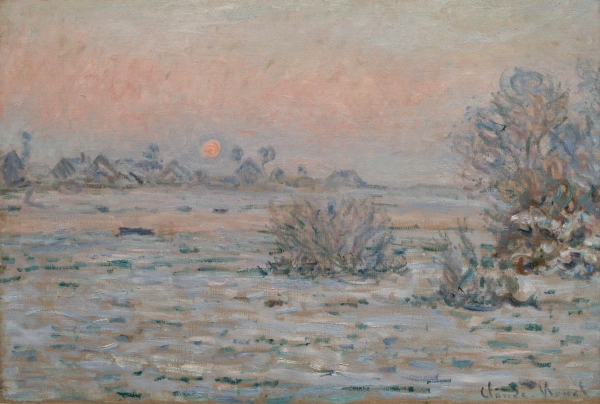
Claude MONET (1840-1926)
Winter Sun,Lavacourt
1879-1880
oil on canvas
55 x 81 cm
© MuMa Le Havre / David Fogel
Winter Sun,Lavacourt
1879-1880
oil on canvas
55 x 81 cm
© MuMa Le Havre / David Fogel
HD image
In September 1878, the Monet family moved to Vétheuil, on the banks of the Seine, around fifty kilometres downstream from Paris. The view from windows on the upper floor of the house looked southwest over a bend in the river. In the winter, the sun set behind the hamlet of Lavacourt, on the opposite shore. From his studio boat moored at the edge of the garden, Claude Monet (1840–1926) worked relentlessly on islands, the riverbank and the Seine, attentive to the changes in the landscape. While he was working on countless views over Vétheuil, the winter of 1879–1880, one of the harshest in history, provided him with a new subject and the elements for a series of twenty-eight paintings.
In December 1879, plunging temperatures froze the Seine under a deep layer of ice almost 50 centimetres thick. When the thaw began in Paris, the situation quickly became catastrophic as the river transported massive blocks of ice and two bridges were swept away. Monet was fascinated by the extreme weather conditions and painted the daily evolution of this exceptional winter in Vétheuil, from December 1879 to March 1880. The snowy landscapes gave way to scenes of the frozen Seine, followed by the thaw.
Fully bathed in a peaceful pink light, Winter Sun at Lavacourt was painted in the heart of winter. The composition is simple, structured around the high horizontal line that corresponds to the opposite bank of the Seine. The village in the background both separates and connects the two contrasting elements of sky and water. The long, even and parallel brushstrokes executed in the lower section of the painting accentuate the horizontal nature of the composition. The painting features a strong division, with unpainted canvas showing through in the reserved areas. The colour harmony of the landscape stems from the contrast between two complementary colours, orange and blue, in keeping with the laws of optics on the decomposition of light that have governed the work of colourist painters since Delacroix.
In December 1879, plunging temperatures froze the Seine under a deep layer of ice almost 50 centimetres thick. When the thaw began in Paris, the situation quickly became catastrophic as the river transported massive blocks of ice and two bridges were swept away. Monet was fascinated by the extreme weather conditions and painted the daily evolution of this exceptional winter in Vétheuil, from December 1879 to March 1880. The snowy landscapes gave way to scenes of the frozen Seine, followed by the thaw.
Fully bathed in a peaceful pink light, Winter Sun at Lavacourt was painted in the heart of winter. The composition is simple, structured around the high horizontal line that corresponds to the opposite bank of the Seine. The village in the background both separates and connects the two contrasting elements of sky and water. The long, even and parallel brushstrokes executed in the lower section of the painting accentuate the horizontal nature of the composition. The painting features a strong division, with unpainted canvas showing through in the reserved areas. The colour harmony of the landscape stems from the contrast between two complementary colours, orange and blue, in keeping with the laws of optics on the decomposition of light that have governed the work of colourist painters since Delacroix.
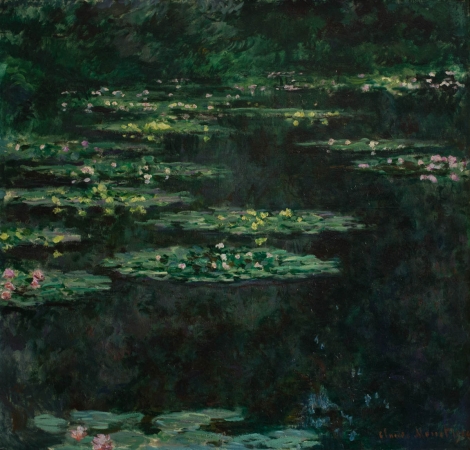
Claude MONET (1840-1926)
Waterlilies
1904
oil on canvas
89 x 92 cm
© MuMa Le Havre / David Fogel
Waterlilies
1904
oil on canvas
89 x 92 cm
© MuMa Le Havre / David Fogel
HD image
In the spring of 1883, after having wandered along the banks of the Seine from Le Havre to Paris for 20 years, Claude Monet (1840–1926) settled in Giverny. The painter participated in the collective adventure of Impressionism and displayed works at the group's four first exhibitions from 1874 to 1879. Crowned with success, he withdrew and purchased the house known as Le Pressoir in 1890. His painting soon took a new direction. While continuing to exalt colour, he delved increasingly deeper into the study of the pictorial space. In 1893, Claude Monet requested permission to divert water from the Ru river to create a "water garden". He made a pond spanned by a footbridge, a reference to his love of Japanese art.
In 1899, through his work on the Waterlilies series, Monet embarked on unprecedented research as he focused almost exclusively on a motif that would become like a signature. Once he had finished the Japanese bridge series in 1900, the artist concentrated on the blooming waterlily pond. First intermittently, when he was not working on the Waterloo Bridgeseries, and then on an ongoing basis when he began a large suite in 1904. From spring to fall, the artist set up easels around the pond so he could capture sensations on several canvases at once and rework them later in his workshop. The Waterlilies at MuMa, painted in 1904, are part of a suite of forty-eight canvases known as "Waterlilies, a Series of Waterscapes" shown at Durand-Ruel's gallery in Paris in 1909.
This square painting emphasizes the decorative potential of colour. The framing eliminates almost all topographical reference to convey the infinite in perpetual motion. Once he had shaped nature and created a space especially for his painting, Monet would tirelessly explore this dominant subject for twenty-seven years. The Giverny garden became a laboratory that led to a genuine transformation of the landscape, in which colour prevails over form. His undertaking thus signalled the abstraction that would be developed by the artists of the New York School in the wake of World War II.
In 1899, through his work on the Waterlilies series, Monet embarked on unprecedented research as he focused almost exclusively on a motif that would become like a signature. Once he had finished the Japanese bridge series in 1900, the artist concentrated on the blooming waterlily pond. First intermittently, when he was not working on the Waterloo Bridgeseries, and then on an ongoing basis when he began a large suite in 1904. From spring to fall, the artist set up easels around the pond so he could capture sensations on several canvases at once and rework them later in his workshop. The Waterlilies at MuMa, painted in 1904, are part of a suite of forty-eight canvases known as "Waterlilies, a Series of Waterscapes" shown at Durand-Ruel's gallery in Paris in 1909.
This square painting emphasizes the decorative potential of colour. The framing eliminates almost all topographical reference to convey the infinite in perpetual motion. Once he had shaped nature and created a space especially for his painting, Monet would tirelessly explore this dominant subject for twenty-seven years. The Giverny garden became a laboratory that led to a genuine transformation of the landscape, in which colour prevails over form. His undertaking thus signalled the abstraction that would be developed by the artists of the New York School in the wake of World War II.


